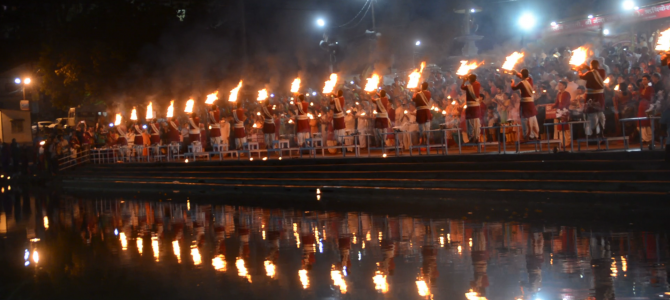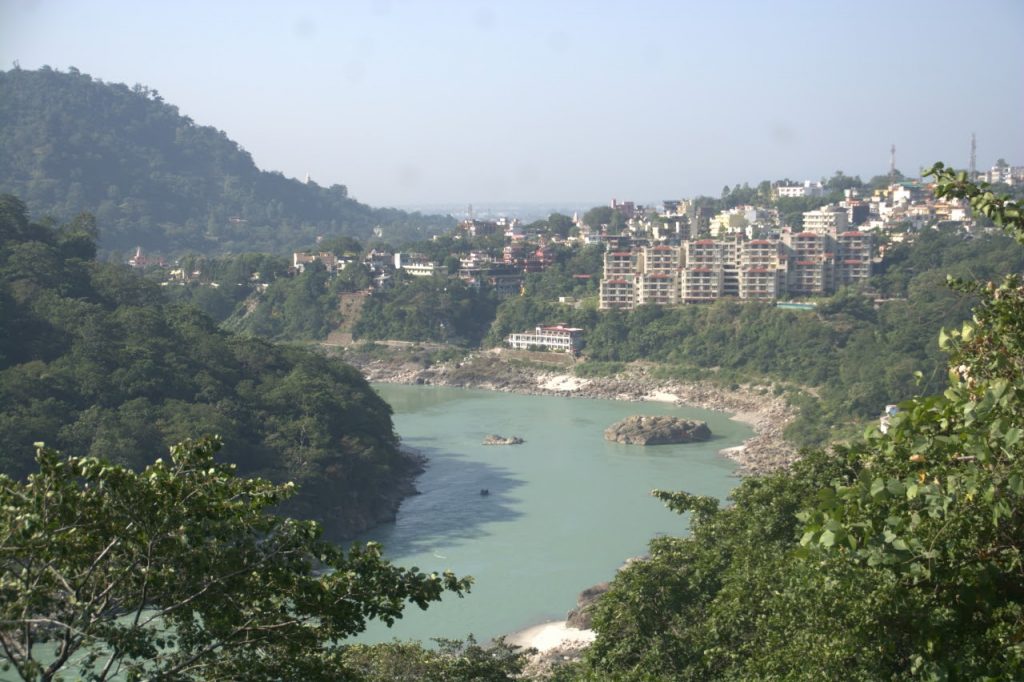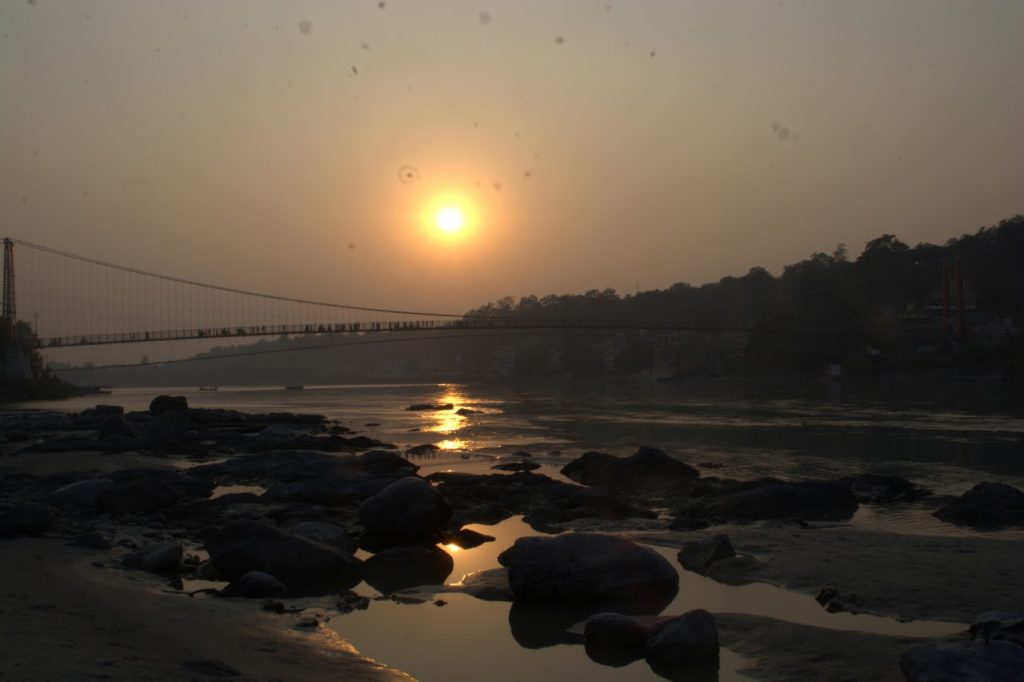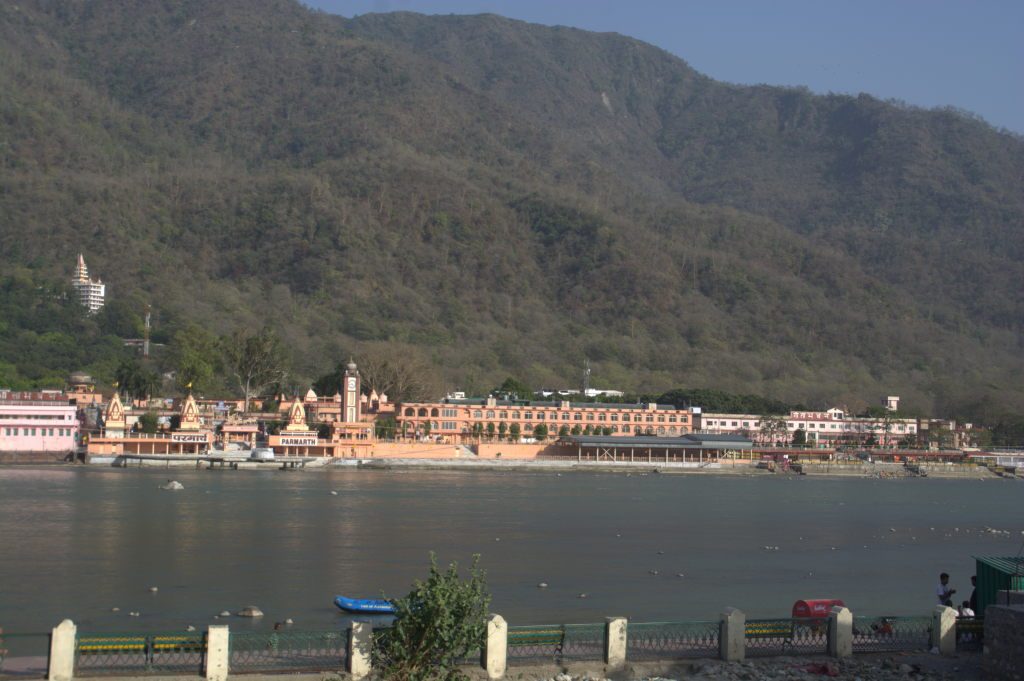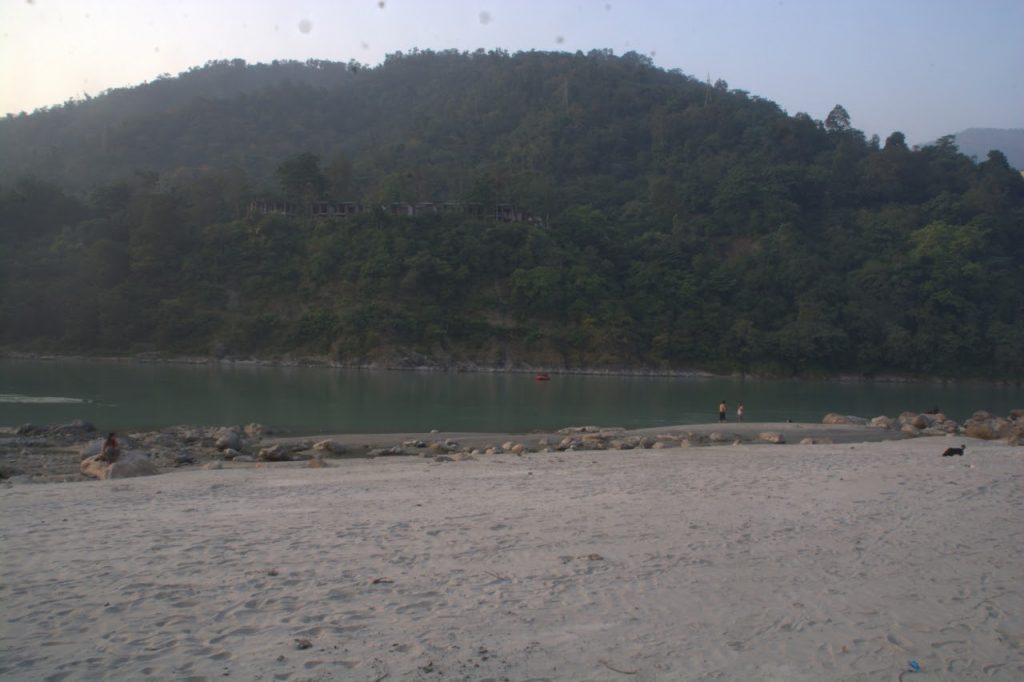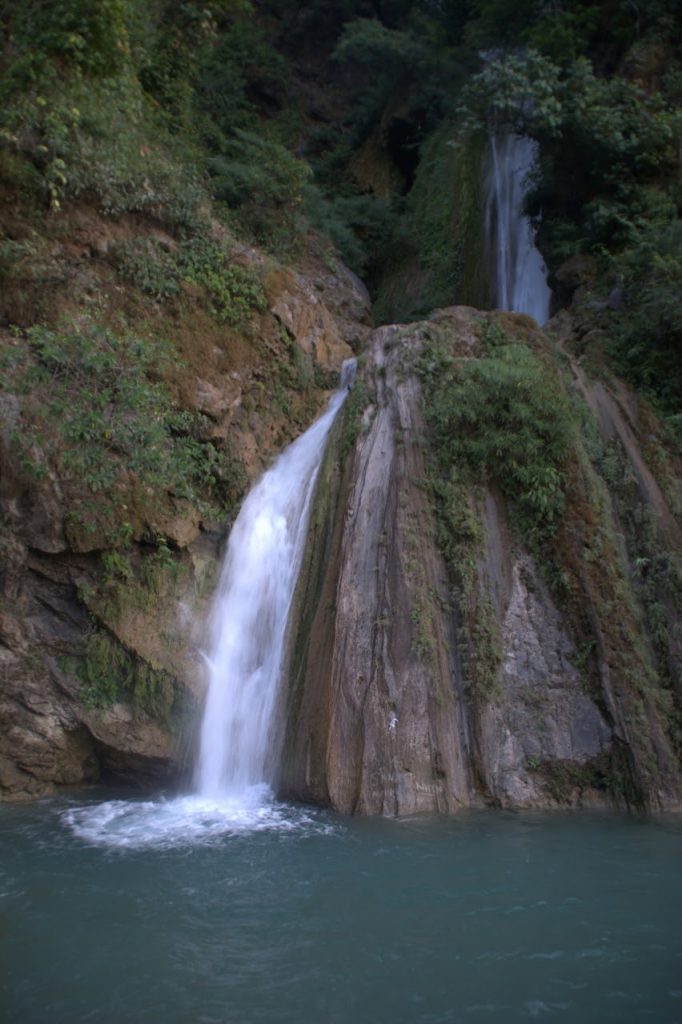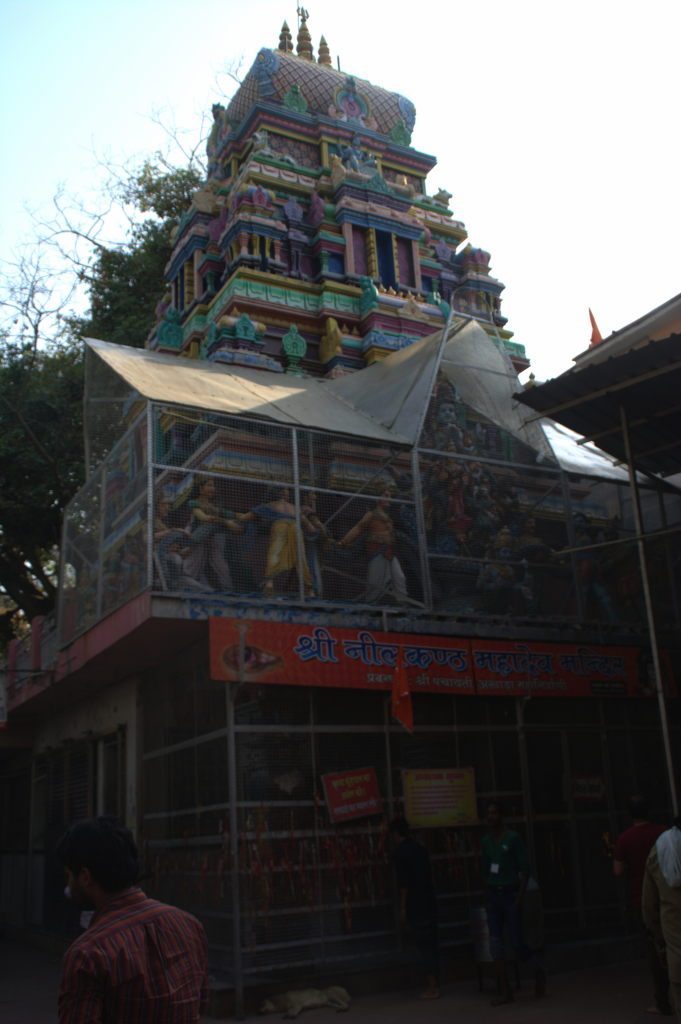Ganga river has a lot of cities on its banks. The first city that Ganga flows through after descending the HImalayas is Rishikesh. Rishikesh is in Tehri Garhwal district and is surrounded by the mountains of the Garhwal range of Himalayas. The city is quite unique in the sense that there is something here for everyone. Whether you want to visit temples and watch Ganga Ghat Aarti, or if you want to learn yoga, or if you want to get your adrenaline pumping with white water rafting and bungee jumping.
Geography of Rishikesh
Ganga river is mainly formed by two major rivers, viz. Bhagirathi and Alaknanda. At Dev Prayag, east of Rishikesh in the same district (Tehri Garhwal), the rivers join forces to form what we know as Ganga. The river continues to hurtle down the Garhwal mountains until it reaches the outskirts of Rishikesh. From the undulating rough slopes of Garhwal mountains, the terrain flattens significantly at Rishikesh, although it still remains gradient enough for the river to form frothy rapids. To the west of Triveni Ghat, once joined by the Chandrabhaga river, the terrain is not longer mountainous and we reach the Gangetic plains of Uttarakhand, leading to Uttar Pradesh. Rishikesh can thus geographically be called the gateway to the Himalayas, although officially that tag is given to Haridwar, 25 km to the south.
While Rishikesh itself is not on the mountains, it is a town with a gradient. The northern part of the town is at a significant altitude compared to the south as the New Delhi – Meerut – Muzaffarnagar – Roorkee – Haridwar – Rishikesh – Joshimath – Badrinath highway starts winding into a curvy slope in preparation for its ascent into the Garhwal mountains. But the river itself remains fairly level. Thus, the southern part of Rishikesh is plush against the river while the northern part overlooks the river from a height. Rishikesh can be classified into 4 distinct localities based on which bank of the river it is on and the altitude above the river.
The southern part of town is the old part and is what is traditionally called Rishikesh. It is right on the west bank of the river to the south of the confluence of Chandrabhaga with Ganga. Just to the south of the confluence is the Triveni Ghat. Old Rishikesh is a marketplace centred around Triveni Ghat. There is nothing across the river from Triveni Ghat. Across the Chandrabhaga river and still on the west bank of Ganga is the township of Muni ki Reti. This part of Rishikesh is mainly residential. Going further to the north, right before the road starts ascending, we come to Ram Jhula, a pedestrian bridge that straddles the river. The west bank is still Muni ki Reti, while the east bank is named Swargashram. This area of Swargashram has several temples, river side beaches, street side eateries, dharamshalas, river side Ghats and temple trusts.
After the highway, which is on the west bank, winds up for a couple of kilometres, it reaches a small locality which has recently grown. This town is named Tapovan. It is home to several hotels, lodges, restaurants, souvenir shops and adventure booking agents. At Tapovan, you can see yet another pedestrian bridge called Laxman Jhula. Crossing the bridge, you reach Swargashram once again. This side of Swargashram is mainly known for yoga classes and several lodges taken by foreigners who come here to learn yoga.
Here are the best places to see and things to do at Rishikesh.
Triveni Ghat
Triveni Ghat is in old Rishikesh at the west bank of Ganga river right to the south of where the Chandrabhaga river joins it. Every evening at sunset (time varies by season), a spectacular prayer performance for Aarti happens at this Ghat. 16 priests stand in a row at a pedestal right by the river and hold up large lamps lit with flames. As chanting and songs are played, the priests move the lamps in all four directions as a offering to the river. The synchronisation is nearly perfect and it is goose-bump inducing to see giant patterns of fire dancing in the wind. You should reach at least 30 minutes before the Aarti happens so that you get ring-side seats. This would mean reaching Triveni Ghat at 6:30 pm during summers and at 5:30 pm during winters.
However here is a tip from India 360. Instead of sitting at the seating space provided at Triveni Ghat’s riverfront, you can take a small risk and get the best view of the Aarti. Customarily, the priests face the river and from the riverfront you can only see their backs for most of the performance. But near the Ghat, the river splits into small rivulets and has created small lagoons of land within the water. The water is shallow and only knee-deep at certain places. You can cross over to one of the lagoons after wading through the shallow parts and make yourselves comfortable. From here you get to the see the priests’s faces as they stand facing the river.
Be advised that you can get away with this method ONLY between November to April. Between May to July, the heat of the summer causes the snow in Garhwal to melt, disgorging a large volume of water into the Himalayan rivers, with Ganga being no different. And between July to October, the monsoon rains cause the rivers to swell. DO NOT attempt to cross the water during such high current months. Also, remember that when you do cross the river, take off your footwear, even if they are just sandals or chappals. Ganga is considered a sacred being and wading through the river is like walking through a divine place. The local people do not take kindly to anyone who walks in the river with footwear worn.
The market around Triveni Ghat has a thriving local market for clothes, religious items, utensils, adventure gear, handicrafts, divine and chanting music, essential oils and spices.
Ram Jhula – Laxman Jhula
Two famous landmarks in Rishikesh are a pair of pedestrian suspension bridges that span the breadth of Ganga river. Both bridges are used to go from the highway on the west of the river to Swargashram area in the east. If you travel around Rishikesh by private or public transport and frequent the river Ghats in the east, you will inevitably end up using the two bridges all day.
The first bridge, Ram Jhula or Ram’s swing, starts from near the Swami Shivanand Ashram at Muni Ki Reti on the west of the river and ends near Rameshwar temple at Swargashram to the east of the river. The second bridge, Laxman Jhula, starts at the slightly elevated Tapovan locality and ends near Tryambakeshwar temple, which is a multi-storeyed building that tapers up like a triangle. Ram Jhula is more famous for its view of several famous river Ghats in Swargashram and the various clean white sandy beaches. Laxman Jhula has excellent views of the meandering river and the imposing Garhwal mountains. On both bridges, you’ll frequently see river rafts with adventure seeking people enjoying the calm downstream length between the two Jhulas.
There are monkeys on both bridges, so be careful with food and loose clothing such as dupattas or shawls. But more than the monkeys, you should be wary of the annoying humans who cross this bridge on two-wheelers despite the clear signboards that say that the bridges are pedestrian. This is because the asphalt road bridges connecting the two sides of the river are at least 6 kilometres away. To quickly move from one part of town to another across the river, the locals have taken to driving on the two bridges. The situation is more difficult if two vehicles from opposite directions use a bridge at the same time. The pedestrians are forced to wait and stick to the wall of the bridge while the offending vehicles wind their way through the bridge, honking at each other and at anyone in their way. Usually they honk through the entire length of the bridge, disturbing the tranquility of the regular sounds of Rishikesh, i.e. the sound of the river flow and the chants coming from temples. What is sad to see is that foreigners who come to Rishikesh for a month or more to learn yoga, also take to this bad habit on their hired two wheelers. In their own countries, they’d never drive over foot-only promenades or honk loudly. But here, the sight of everyone breaking best practices emboldens them to do the same.
River side Ghats
As with any river side city in India, and especially like those along Ganga, Rishikesh has its share of river side Ghats. While there are several Ghats, the most famous are Triveni, Parmarth, Vanprasth, Shivanand and Bombay. We have already featured Triveni Ghat in a paragraph above. Here are the four other major Ghats.
Shivanand Ghat: is to the west of the river in the locality of Muni ki Reti near Shivanand Ashram. While the Ghat itself doesn’t draw many people, it serves as the entry to Ram Jhula bridge. There are several shops dotting both sides of the path towards the entrance. You can get both food items and souvenirs. Another significance of Shivanand Ghat is that all rafting activities end at the shores of this Ghat.
Bombay Ghat: is a series of stairs that goes towards the east bank of river immediately to the north from Laxman Jhula bridge. This is a great spot to see the sun set over the Laxman Jhula bridge in the evening. Right near the Bombay Ghat is the Tryambakeshwar temple with its dharamshala.
Parmarth Ghat: This Ghat is among the most popular Ghats in Rishikesh and certainly the most popular to the east of the river (Swargashram area). The Ghat features a clock tower which is called the Shanti Stambh or Peace Tower. This Ghat also features an evening Aarti, although not as grand as the one at Triveni. In this Ghat, the prayer is performed on a concrete platform that juts into the river from the riverfront.
Vanprasth Ghat: This Ghat’s seclusion is in complete contrast to the popularity of Parmath Ghat, hardly 200 metres away. If you want to spend a quiet dusk away from the constant chatter of people and honking of vehicles, then this is the Ghat to be in. The most special feature of this Ghat is the platform’s proximity to the fast-flowing river water. If you sit on the platform and hang your legs (footwear free, of course) off the ledge, then your feet will be in the cool Himalayan waters of the river. At this place, the river flows calmly, but at a ferocious speed due to the gradient and due to having just exited the mountains. Just 3 km downhill at Triveni Ghat, the river slows down enough and spreads thin enough for you to be able to walk in the water.
River beaches
There are a handful of river-side beaches in Rishikesh, but the most impressive one is just to the north of Ram Jhula on the eastern bank of the river (Swargashram). The beach here is quite long and the water really clear. It is also a spectacle to watch the sun set over Ram Jhula from this beach. Mark this beach as one of the things to do either early in the morning or in the hour before sunset.
Adventure sports
Rishikesh has mainly two popular adventure sports: river rafting and bungee jumping.
The geography of Rishikesh is perfect for one of the best white water rafting experiences India has to offer. Ganga river descends at a ferocious speed from the slopes of Garhwal, but the speed is cut back enough by the time the river reaches the gently slopes Rishikesh town. Slow enough for attempting rafting, but fast enough to create vortices and rapids around the areas where it has to negotiate rocks and rivulet confluences. There are rafting experiences of different lengths, mostly 14 km, 16 km and even a few that offer 21 km. The rafts are set free from nearby villages such as Shivpuri and Dhunar. A typical ride goes through at least 3 major rapids and 5-6 minor ones. In the calmer parts of the ride, where the river’s current takes care of the direction at a cruising speed without active rowing, the participants are encouraged to jump into the water with their hands or feet tethered to the raft with a strong rope. The dip in the river is quite refreshing.
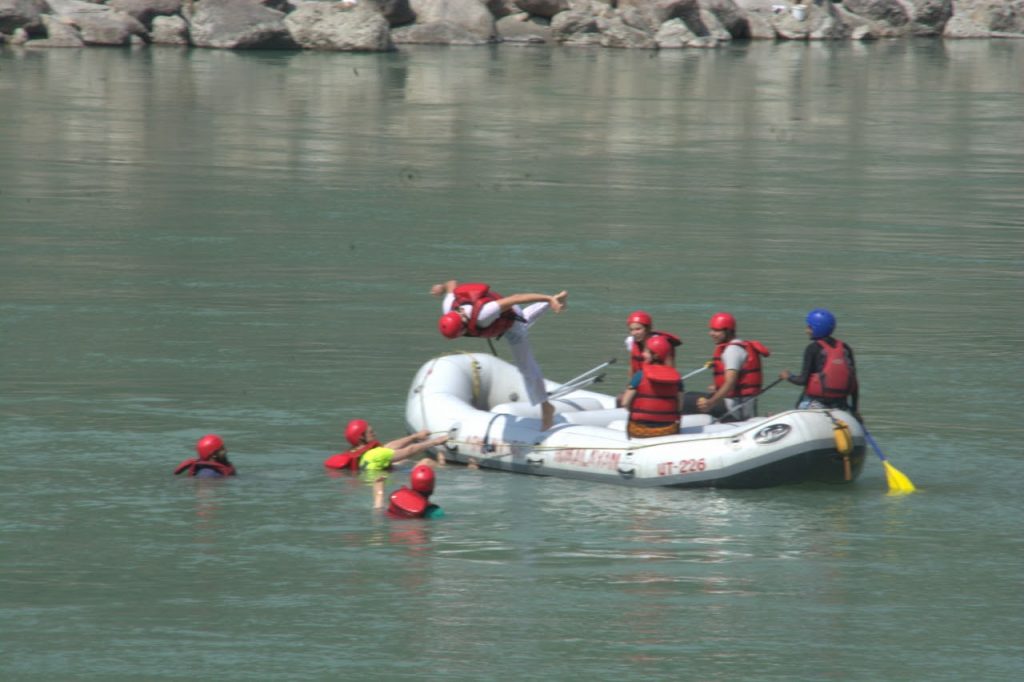
A participant jumps of the raft in the calmer part of the river during a white water rafting ride near Rishikesh
A funny thing happens during the ride. You can classify it as ‘It Happens Only In India’. Halfway between Shivpuri and Rishikesh, all rafts stall by the river bank for a ‘break’. It gives the rafting participants some time to relax their rowing muscles. What makes this break interesting is that some local villagers arrive at the spot to sell tea and Maggi. Nowhere in the entire world will you see a ‘chai break’ in the middle of a rafting experience!
Another not-to-miss experience at Rishikesh is bungee jumping. A company named “Jumpin’ Heights” conducts the jumps at a town about 20 km north of Rishikesh, as the slopes of Garhwal start ascending enough to leave the river behind in a deep valley below. On one such slope, the company has built a 275-feet (83 metres) platform. When you go during off-season, your jump will be entertained almost instantly. But during peak season, the platform has a long queue of wanna-be jumpers, some of them who turn back without facing their fears!
Two kinds of jumps are offered. One jump is called a ‘giant swing’, where a rope is tied around your waist. After you jump and the rope becomes taut, you are swung from side to side, wihile getting to see a breathtaking view of the Ganga valley. Another jump is ‘bungee’, where the rope is tied to your feet and you let yourself go off the platform head down. In this jump, as the rope gets taut, you are jerked up and down for a couple of minutes and the whole world seems upside down. The man who inspects and conducts each jump is from New Zealand, a country known to be crazed about bungee jumping. Despite his expertise, the man is humble and would never force anyone to jump by pushing him/her off the platform.
Neer waterfall
3 kilometers to the north of Rishikesh is a trail that leads to a multi-cascading waterfall formed on a river that joins Ganga. Three of the cascades can be visited by foot. At each cascade, the fall forms a pool with azure and clear water. If you fill the water in a clear glass or plastic bottle, you can see through.
Neelkanth Mahadev
Neelkanth Mahadev is a hill top temple dedicated to the blue-throated Lord Shiva. According to Hindu mythology, especially the Kurma Avatar story, it was at this location that Lord Shiva consumed the poison that erupted as a result of Devas and Asuras churning the sea in a quest to obtain Amrit or elixir. After consuming the poison, Lord Shiva’s throat turned blue.
Curiously, this temple has a south Indian shaped and styled dome. The sculptures on the dome show the scene of Samudramanthan or the churning of the sea.
Kunjapuri
Kunjapuri is a hill top temple dedicated to Goddess Parvati. Apart from the Goddess, the temple is famous for its panoramic view of Swarga Rohini peak and Gangotri glacier. The sunrise from the top of this temple is quite spectacular and this fact is used by the foreigners who come to Rishikesh to leann yoga. You will find several yoga practitioners arriving here at the crack of dawn to perform Surya Namaskar. The staircase that leads to the temple has the lines of the Devi Shloka ‘Ya Devi Sarva Bhooteshu’, with one line written on each step. A walking trail connects Kunjapuri temple to Neer waterfall.
Vashishth Guha
This is a small cave at the base of a hill on the shore of the Ganga river. This cave is said to have been used by sage Vashishth to reside and meditate. The cave has a Shiva Linga and a few lamps. The acoustics of the cave have been designed such that there is pin drop silence inside the cavern. You cannot hear even the rush of the river flowing outside. At the base of the same hill about 100 metres to the south is another cave known as Arundhati cave.
The ambience of Rishikesh
While at Rishikesh, a few things are constant about the ambience in the entire town. The sound of the river follows you wherever you go, whatever time of the day it is. This is because of the speed at which the river flows and the numerous rocks that it negotiates along the way. Due to the presence of various temples, prayer points, yoga centres and prayer item shops, you will smell the fragrance of incense, camphor, ash and essential oils everywhere in town. The sight of ascetics in their dreadlocks and saffron robes meditating by the river side is also quite common.
Something unique to, but all pervasive in Rishikesh is that all music shops play two specific music tracks all day. A shloka and a bhajan recited by foreign artistes. One of them is ‘Namastasyai Namastasyai’ Devi Shloka, while the other is ‘Jai Shiva Shambho’ bhajan, both recited in obviously foreign accents!
Places to stay
Rishikesh has everything from sparse temple trustee rooms to 5-star hotels. In Swargashram, on the road that runs parallel to the river near the Ram Jhula, there are several temple trust Yatri lodges such as Baba Kaali Kamli, Vanprasth Ashram and Ved Niketan Dham. Near Laxman Jhula, one can look for Yatri Niwas rooms in the Tryambakeshwar temple. The entire length of Swargashram is dotted with cottages where you can book a month or more of stay if you plan to stay for yoga classes. These cottages are usually taken over by foreigners during peak season.
If you prefer to stay in the modern ambience of Tapovan locality, which is also right on the highway, then Zostel is your best option. If you prefer an upscale stay with your family, then you can opt for places such as Narayana Palace or Aloha.
What to eat
If you do not like street food or prefer the safety of restaurants, then there are good restaurants like Choti wala (near Ram Jhula) and Tip Top (Tapovan). There are also several good restaurants in the area around Triveni Ghat, near Rishikesh bus depot and railway station.
We at India 360 have a clear preference for street food, local delicacies and open kitchen restaurants over huge family restaurants and restaurant joints. So here is what we enjoyed. Chhole kulche and aloo tikki from one of the several street side vendors near Ram Jhula. Roadside tea in a glass near the river beach at Ram Jhula. Traditional daal rice and roti at one of the several family run eateries in Tapovan area in open kitchen style, where you can see your food being prepared in front of you. Ram fal from one of the fruit vendors near Ram Jhula. Our favourite was street-baked biscuits (naankhatai) by a person working on a charcoal powered oven near Ram Jhula. This person had regular naankhatais and also ones in chocolate flavour.
Conclusion
Enough said. To be honest, Rishikesh is not the type of town you can learn about by reading a 3000-word blog post. You have to be there to experience the town. The influence of Ganga river, the divinity and tranquility of the Ghats, the adrenaline rush of the adventures and the village fair like ambience of Triveni Ghat market. The best times to visit Rishikesh are during October and during April. So plan you next trip now. There is a reason why Rishikesh made it to the India 360’s list of top 5 destinations in the country.

